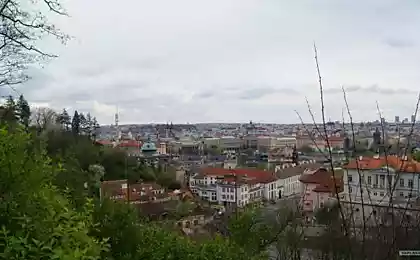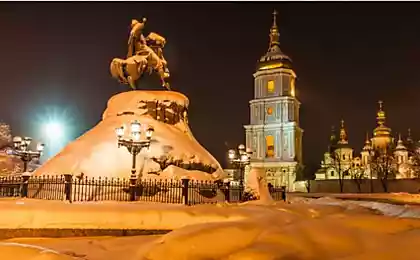1286
Mexcaltitan - a city on the water
Mexcaltitan (App. Mexcaltitán), full name Mexcaltitan de Uribe (App. Mexcaltitán de Uribe) - village in Mexico, the State of Nayarit, the municipality of Santiago Iskuintla located on the same island.
Nahuatl Mexcaltitan (Mexcaltitan) means "island, full of mescal" (a strong alcoholic beverage).
Mexcaltitan (Mexcaltitán) - not just a picturesque island town with a population of 2000 inhabitants. Archaeological excavations have shown that Mexcaltitan opportunity to be on the site of the legendary ancient city of Aztlan ("land of herons"), from which the Aztecs called themselves "Mexica» (May-Kshee-kah), in 1091 went to the south in the valley of Mexico.

Every year, on 28 and 29 June, the town held a grand carnival in honor of Saints Peter and Paul. During the festival the inhabitants of nearby villages Mexcaltitan and dress up in costumes from the skins of jaguars and decorate their hairstyles bright feathers, continuing the tradition of their ancestors. The season shrimp townspeople notes the great regatta ships, decorated with images of Saints Peter and Paul.

According to a version that has not received sufficient scientific evidence, Mekskaltitan - a legendary Aztlán, the ancestral home of the Aztecs, where they were in 1091 set off on a journey in search of a better place to live and settled in one and a half thousand kilometers - in Tenochtitlan (now Mexico City).
According to one legend, during the long journey to the promised land of the Aztecs staged overnight on the island. However, in the course of excavations carried out on the island no Aztec artifacts were found.
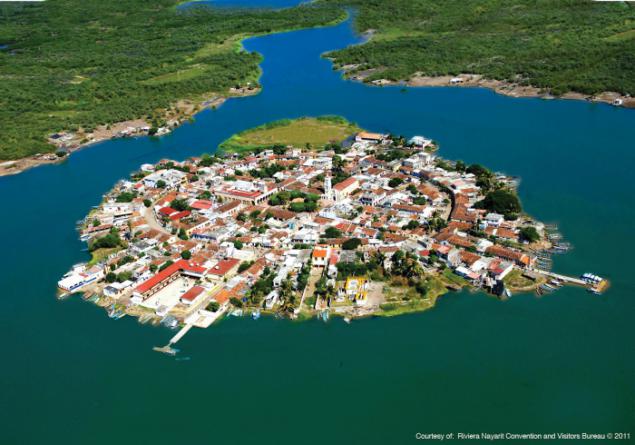
Mexcaltitan, whose full name Mexcaltitan de Uribe (App. Mexcaltitán de Uribe), a small town in the Mexican state of Nayarit, located on the same island off the Pacific coast of Mexico. By giving, this is where the Aztec civilization originated.

The diameter of the island is less than 400 meters.
The town lies in a picturesque lagoon amidst lush mangrove forests.

Mexcaltitan located in a swampy area. It is surrounded by numerous channels formed by mangroves.
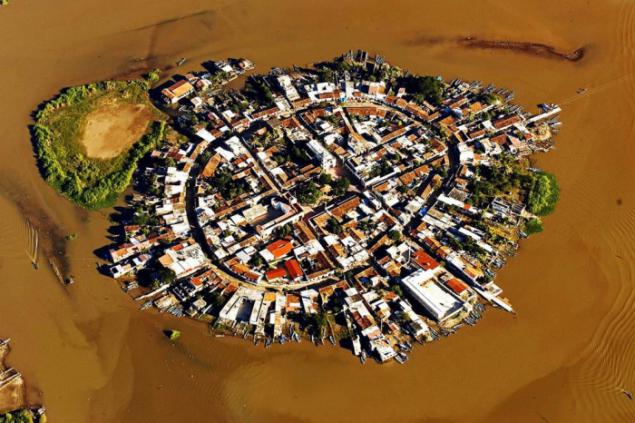
The rainy season lasts from August to September. At this time, the city streets turned into canals.
City trades shrimp According to one version, Mexcaltitan located on the site of the ancient city of Aztlan, the cradle of the Aztec civilization. It was here in 1091 they migrated to the south and founded the settlement of Tenochtitlan (now Mexico City).

According to legend, the Aztecs settled on the island for the night during a long journey.
Nowadays, all the inhabitants of Mexcaltitan ply shrimp.
In the rainy season floods the streets of the city, and the inhabitants move around in boats.
It is noteworthy that the city does not have crime, for that matter, and tourism infrastructure.

Mexcaltitan is located approximately 32 kilometers north-west of the city of Santiago Iskuintla (Santiago Ixcuintla), which can be reached either on a country road from San Blas, or on the 15th highway, turning 60 km north of Tepic (Tepic ). After about 8 km after the turn, you will see the city of Santiago Iskuintla, the right of which is a small hill.

After passing the hill, turn right and find yourself on the street on November 20, the main street running through the central square. Across the street lies the main road to the west. On it you have to drive another 8 kilometers to the sign "turn on Mexcaltitan." Here, turn right and move forward past the base of "Aztlan" (the object of experimental Rocket Center Mexcaltitan). Next you find yourself in a maze of picturesque lagoons with mangroves inhabited by colorful singing waterfowl. After passing 24 km after the turn, you will reach the pier, which can in papast Mexcaltitan.

Please note: Mexcaltitan can also be reached from the north-east, moving along the 15th highway (219 km) south of Mazatlan. Near the sign "turn to the Mexcaltitan" far away from the filling station at 6, 5 km south from the town of Chilapa (Chilapa). Initially, the road was paved with tiles, but now it is the other half passing through swampy terrain, lined with gravel. Here you will see the lotus flowers of the Mexican and whole flocks of egrets and cormorants. Passing thus 45 km, you finally reach the dock of La Ticha (La Ticha).


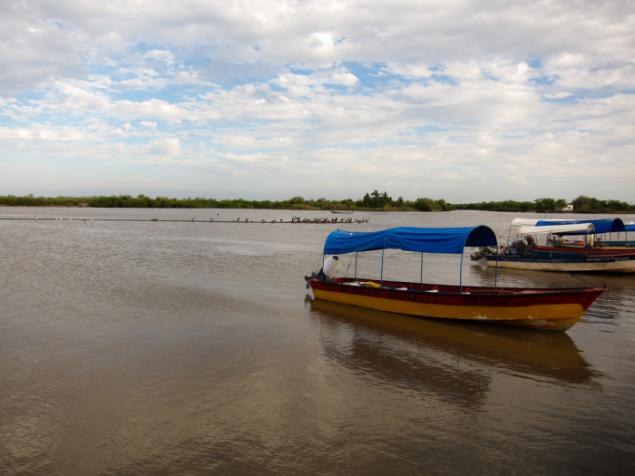









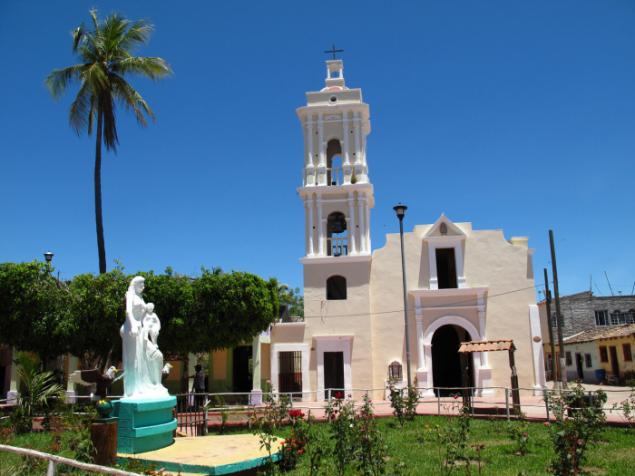
©
Nahuatl Mexcaltitan (Mexcaltitan) means "island, full of mescal" (a strong alcoholic beverage).
Mexcaltitan (Mexcaltitán) - not just a picturesque island town with a population of 2000 inhabitants. Archaeological excavations have shown that Mexcaltitan opportunity to be on the site of the legendary ancient city of Aztlan ("land of herons"), from which the Aztecs called themselves "Mexica» (May-Kshee-kah), in 1091 went to the south in the valley of Mexico.

Every year, on 28 and 29 June, the town held a grand carnival in honor of Saints Peter and Paul. During the festival the inhabitants of nearby villages Mexcaltitan and dress up in costumes from the skins of jaguars and decorate their hairstyles bright feathers, continuing the tradition of their ancestors. The season shrimp townspeople notes the great regatta ships, decorated with images of Saints Peter and Paul.

According to a version that has not received sufficient scientific evidence, Mekskaltitan - a legendary Aztlán, the ancestral home of the Aztecs, where they were in 1091 set off on a journey in search of a better place to live and settled in one and a half thousand kilometers - in Tenochtitlan (now Mexico City).
According to one legend, during the long journey to the promised land of the Aztecs staged overnight on the island. However, in the course of excavations carried out on the island no Aztec artifacts were found.

Mexcaltitan, whose full name Mexcaltitan de Uribe (App. Mexcaltitán de Uribe), a small town in the Mexican state of Nayarit, located on the same island off the Pacific coast of Mexico. By giving, this is where the Aztec civilization originated.

The diameter of the island is less than 400 meters.
The town lies in a picturesque lagoon amidst lush mangrove forests.

Mexcaltitan located in a swampy area. It is surrounded by numerous channels formed by mangroves.

The rainy season lasts from August to September. At this time, the city streets turned into canals.
City trades shrimp According to one version, Mexcaltitan located on the site of the ancient city of Aztlan, the cradle of the Aztec civilization. It was here in 1091 they migrated to the south and founded the settlement of Tenochtitlan (now Mexico City).

According to legend, the Aztecs settled on the island for the night during a long journey.
Nowadays, all the inhabitants of Mexcaltitan ply shrimp.
In the rainy season floods the streets of the city, and the inhabitants move around in boats.
It is noteworthy that the city does not have crime, for that matter, and tourism infrastructure.

Mexcaltitan is located approximately 32 kilometers north-west of the city of Santiago Iskuintla (Santiago Ixcuintla), which can be reached either on a country road from San Blas, or on the 15th highway, turning 60 km north of Tepic (Tepic ). After about 8 km after the turn, you will see the city of Santiago Iskuintla, the right of which is a small hill.

After passing the hill, turn right and find yourself on the street on November 20, the main street running through the central square. Across the street lies the main road to the west. On it you have to drive another 8 kilometers to the sign "turn on Mexcaltitan." Here, turn right and move forward past the base of "Aztlan" (the object of experimental Rocket Center Mexcaltitan). Next you find yourself in a maze of picturesque lagoons with mangroves inhabited by colorful singing waterfowl. After passing 24 km after the turn, you will reach the pier, which can in papast Mexcaltitan.

Please note: Mexcaltitan can also be reached from the north-east, moving along the 15th highway (219 km) south of Mazatlan. Near the sign "turn to the Mexcaltitan" far away from the filling station at 6, 5 km south from the town of Chilapa (Chilapa). Initially, the road was paved with tiles, but now it is the other half passing through swampy terrain, lined with gravel. Here you will see the lotus flowers of the Mexican and whole flocks of egrets and cormorants. Passing thus 45 km, you finally reach the dock of La Ticha (La Ticha).













©









